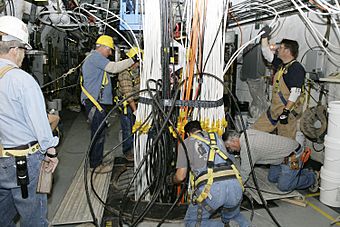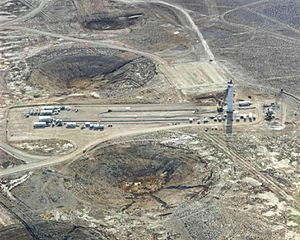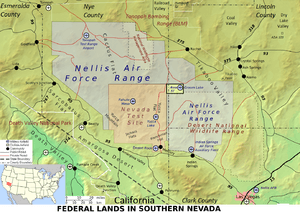British nuclear testing in the United States facts for kids
Quick facts for kids NTS series |
|
|---|---|

Krakatau subcritical experiment being lowered into the floor of the tunnel of the U1a Complex at the Nevada Test Site (2006). The cables extending from the hole will carry data from the experiment to recording instruments.
|
|
| Information | |
| Country | United Kingdom |
| Test site | NTS Area 19, 20, Pahute Mesa; NTS, Areas 1–4, 6–10, Yucca Flat |
| Period | 1962–1991 |
| Number of tests | 24 |
| Test type | underground shaft |
| Max. yield | 140 kilotonnes of TNT (590 TJ) |
| Navigation | |
| Previous test series | Operation Grapple |
After the United Kingdom successfully developed its own thermonuclear weapons (also known as hydrogen bombs) in a project called Operation Grapple, it became the third country to have them, after the United States and the Soviet Union. Britain then started talking with the US about sharing information and materials for designing, testing, and maintaining these powerful weapons.
These discussions led to the 1958 US–UK Mutual Defence Agreement. This agreement allowed Britain to use the United States' Nevada Test Site for its nuclear tests. In return, the US received all the data from these experiments. This meant the Nevada Test Site became Britain's main testing ground. From 1958 until nuclear testing ended in the US in September 1992, Britain conducted 24 underground tests there.
Later, the United Kingdom signed the Comprehensive Nuclear Test Ban Treaty in 1996 and officially agreed to it in 1998. This showed Britain's strong commitment to stopping nuclear test explosions around the world.
Contents
Why Britain Needed Tests
During the early part of Second World War, Britain had its own secret project to build nuclear weapons, called Tube Alloys. In 1943, the British Prime Minister, Winston Churchill, and the US President, Franklin Roosevelt, signed an agreement. This agreement combined Britain's project with the American Manhattan Project. They worked together to create the first atomic bombs.
Britain expected to keep sharing nuclear technology with the US. However, a US law passed in 1946, called the United States Atomic Energy Act of 1946 (McMahon Act), stopped this sharing. Britain worried that the US might become isolated again, like after the First World War. If that happened, Britain might have to face threats alone. To keep its important role in world affairs, Britain restarted its own nuclear weapon development, named High Explosive Research.
Building atomic bombs meant they also needed to test them. Britain didn't have large, empty areas for testing. So, British officials looked for sites overseas. They first asked to use the American Pacific Proving Grounds, but the US said no in 1950.
As an alternative, the uninhabited Monte Bello Islands in Australia were chosen. Meanwhile, Britain kept asking the US to use the Nevada Test Site. Some US officials liked the idea, but others worried about security. They wanted Americans to conduct the tests, with only a few British scientists watching. President Harry S. Truman agreed with this idea in 1951.
Using the Nevada Test Site would be cheaper for Britain. However, Britain would have to share all its test information with the US, but the US would not share its own data. In the end, Britain chose Monte Bello. The first British atomic bomb was tested there in Operation Hurricane in October 1952. Later, Britain used the Maralinga test site in Australia for more tests.
Even though Britain successfully developed atomic bombs, the US didn't fully restore their nuclear partnership. In November 1952, the US tested Ivy Mike, the first true thermonuclear weapon (hydrogen bomb). This meant Britain was still years behind in nuclear technology.
British leaders decided they must develop their own hydrogen bombs. This was to keep Britain's position as a strong world power. In July 1954, the government agreed to start developing these weapons.
Australia would not allow thermonuclear tests. So, Christmas Island in the Pacific was chosen for Operation Grapple. The US also claimed this island and helped with the tests. After some early challenges, the Grapple X test in November 1957 was a success. Britain became the third country to develop hydrogen bomb technology. British scientists showed they could make a powerful hydrogen bomb that was also small enough to be useful.
A worldwide agreement to stop nuclear testing in the atmosphere began in October 1958. Britain never tested nuclear weapons in the atmosphere again.
A New Partnership
When the Soviet Union launched Sputnik 1 in October 1957, it surprised many Americans. This event, called the Sputnik crisis, created a chance for the US and Britain to improve their relationship. Their friendship had been strained by the Suez Crisis the year before.
British Prime Minister Harold Macmillan wrote to US President Dwight D. Eisenhower. He suggested that the two countries combine their efforts. He believed they should work together to face the Soviet challenge in every way.
The McMahon Act was changed to allow some sharing of nuclear weapon data. It also allowed sharing non-nuclear parts of nuclear weapons. This was only for countries that had made significant progress in this field. Only Britain met this requirement.
President Eisenhower signed the new law in July 1958. The 1958 US–UK Mutual Defence Agreement (MDA) was signed the next day. This agreement brought the "Special Relationship" between the two countries back. Macmillan called it "the Great Prize."
How Tests Were Done
The MDA didn't directly talk about British nuclear testing at the Nevada Test Site (NTS). However, it created a way for it to happen. British officials asked to use the NTS for testing.
In 1961, Prime Minister Macmillan asked President John F. Kennedy to use the NTS. He wanted to test a new British warhead called Super Octopus. This warhead was important to both British and American weapon designers. The answer was positive. In February 1962, it was announced that Britain would conduct a nuclear test at the NTS.
This led to a process for approving British nuclear tests. The head of Britain's Atomic Weapons Research Establishment (AWRE) would send a request. This request would go through several US officials, including the President. Every test needed approval from the President and the National Security Council.

A special group called the Joint Working Group (JOWOG) was formed. Its job was to organize the British tests. The US was responsible for safety and containing the tests. The JOWOG decided that Britain would provide the test device and its measuring tools. The US would provide everything else, like the test container and cables. These cables would send test information to US recording equipment.
The first British underground test was called Pampas. It happened on March 1, 1962. A new part of the weapon, called the Super Octopus implosion system, worked. But the overall result was not as good as hoped. The warhead, called RO.106 (Tony), used a different, safer explosive than the American version. This made it less powerful.
A follow-up test, called Tendrac, happened in December 1962. This test was successful. It helped create the design for the WE.177 weapon.
Different Types of Tests
Subcritical tests are nuclear weapon tests that do not cause a nuclear explosion. They involve nuclear materials and explosives but are designed not to reach a critical mass. Safety tests check how nuclear weapons react to things like fire or shocks. These tests are not meant to cause an explosion, but there is always a small risk.
Some subcritical and safety tests were done in Australia. But four more British safety tests happened in 1963 at the NTS Tonopah Test Range. These were part of Operation Roller Coaster. The Partial Nuclear Test Ban Treaty started in October 1963. It banned nuclear testing in the atmosphere. Because of this, the Maralinga test site in Australia was closed in 1967.
New Warheads and Challenges
In 1963, Britain signed the Polaris Sales Agreement. This meant a new warhead was needed for the Polaris missile. British scientists visited the US to learn about the American W58 warhead. However, they couldn't just copy it. Britain used different explosives and different types of isotopes of plutonium. So, they had to design a new warhead. It was named ET.317.
A new series of tests began. The first was Whetstone Cormorant in July 1964. Then came Whetstone Courser in September. This test failed because of a problem with an American-made part. It had to be repeated.
The repeat test, Flintlock Charcoal, happened in September 1965. This test had to be approved by Prime Minister Harold Wilson and his government. Charcoal produced the biggest explosion of any UK test at NTS up to that point. This design saved a lot of plutonium and money. This was Britain's last nuclear test for nine years. In 1965, Wilson stopped all nuclear testing, saying it wasn't needed.
In 1972, Britain got permission for three more tests at the NTS. These were part of the Chevaline program. This program aimed to make Britain's Polaris missiles stronger against Soviet defenses. The first test was Arbor Fallon in July 1974. It was followed by Anvil Banon in August 1976 and Cresset Fondutta in April 1978. These tests aimed to make the warheads lighter. A lighter warhead meant the missiles could travel farther.
In 1976, the Threshold Test Ban Treaty limited tests to 150 kilotonnes of TNT (630 TJ). Three more Chevaline tests were added. Quicksilver Quargel in November 1978 tested a warhead that could survive fast re-entry into the atmosphere. It worked as planned. Quicksilver Nessel in August 1979 tested a new lightweight part. Finally, Tinderbox Colwick took place in April 1980.
Starting with Guardian Dutchess in October 1980, British tests focused on developing a warhead for the UK Trident missile system. The decision to get Trident meant British designers could access American data on how nuclear weapons affect military systems. This greatly influenced their designs.
Many of these later tests moved to the Pahute Mesa area of the NTS. This was because tests there would have less impact on nearby cities like Las Vegas. The final British test at NTS was Julin Bristol in November 1991.
In total, Britain conducted 24 nuclear tests at the NTS.
After Nuclear Explosions
Plans were being made for another test in 1992. But then President George H. W. Bush announced a pause in testing. This surprised both American and British staff at the NTS. The next President, Bill Clinton, extended this pause.
In 1996, the United States signed the Comprehensive Nuclear Test Ban Treaty (CTBT). However, the US Senate did not officially approve it in 1999. The United Kingdom signed the CTBT in 1996 and approved it in 1998. This made Britain, along with France, the first two of the five declared nuclear-weapon states to agree to the treaty. This approval showed Britain's commitment to ending nuclear test explosions worldwide.
Subcritical tests are experiments that involve nuclear materials and sometimes chemical explosives. They are designed so that no nuclear explosion happens. This means they don't create a critical mass of nuclear material. These are the only types of tests allowed under the CTBT, as agreed by the major nuclear powers. Britain has continued to conduct subcritical nuclear tests in the United States, such as Etna (Vito) in 2002 and Krakatau in 2006.
Images for kids
-
Preparing for an underground test at the Nevada Test Site. Final test preparations include running miles of cable downhole which will transmit vital test information to the diagnostic trailers to the left. A rack containing instrumentation to go downhole is assembled in the tower to the right. Subsidence craters from earlier underground tests dot the landscape.









